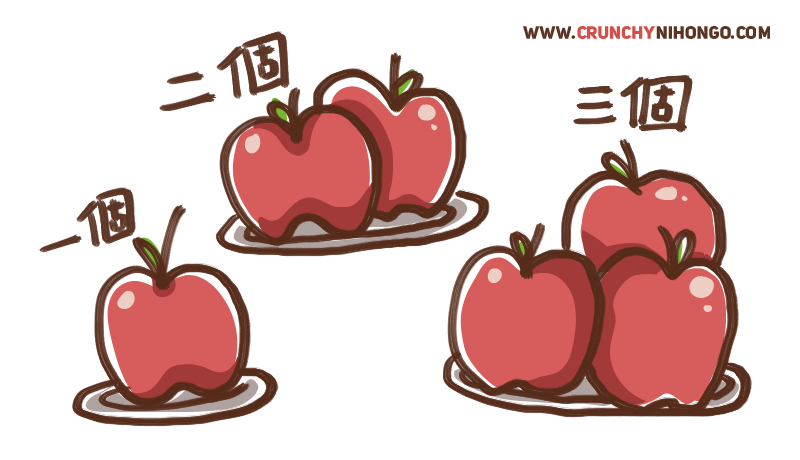Hi ! We hope this site helps you! ٩(ˊᗜˋ*)و As an Amazon Associate, we earn from qualifying purchases without additional cost. Click to read more about our Privacy Policy or Affiliate Disclosure
Today we’ll be talking about how to count in Japanese. Counting in Japanese requires more than just numbers! It might be hard to grasp at first, but it’ll eventually feel natural if you keep practicing it! Let’s start!
As what we wrote above, when you want to count things in Japanese you cannot just use the Japanese number. To count in Japanese, we need COUNTERS.

But I’ve heard somewhere that we could count using hitotsu, futatsu?
Yes you’re correct! But that’s only works for objects up to 10 and it can’t be used to count all stuff. For example, you can’t use it to count people. We’ve covered basic counting here, so be sure to check it out!
COUNTERS
Counting in Japanese is a bit complex. You need to add a proper counter words for the things you are about to count. But that’s not all! What makes it hards is that… after adding the counter words in the back of number, it might change the way the number is read!
For example, 4 is read as よん (yon) or し (shi). When we count money by adding 円 (えん en) counter in the back. It’s not よんえん YONEN or しえん SHIEN. but it becomes YOEN.
Another example is 1. Normally, it read as いち. But when we count age using 歳(さい sai) counter, it becomes いっさい (issai) instead.
But don’t worry, as most of of them will follow a specific pattern. Basically you will need to add a specific counter after a number.
The formula is NUMBER + COUNTER
If you haven’t learned about Japanese numbers yet, check it out here.
For the main samples, we will use 冊 (counter for magazine/books)
一冊 : いっさつ : [issatsu] : 1 book — [(irregular)]
二冊 : にさつ : ni satsu : 2 books
三冊 : さんさつ : san satsu : 3 books
四冊 : よんさつ : yon satsu : 4 books
五冊 : ごさつ : go satsu : 5 books
六冊 : ろくさつ : roku satsu : 6 books
七冊 : ななさつ : nana satsu : 7 books
八冊 : はっさつ : [hassatsu] : 8 books — [(irregular)]
九冊 : きゅうさつ : kyuu satsu : 9 books
十冊 : じゅっさつ : [jussatsu] : 10 books — [(irregular)]
IRREGULARS
As you can see above, 一冊 is not ichi satsu and 八冊 is not hachi satsu.
You might counter a lot of irregulars too in other counters and they are quite random. Mostly they are in the number 1, 3 , 6 or 8. The fuse and sound change such as 三百 (san byaku) and 八百 (happyaku) actually have a rule of thumb. But they are quite complex though. It’s much easier to just remember that 300 is sanbyaku and 800 is happyaku.
There are also true irregulars such as 一人 (hitori) and 二人 (futari). They don’t have any kind of rule. So you can only memorize them. Okay so now we’re ready to learn about other counters.
Common & Useful Counters
人 (nin)
Counting Human. Yes, it’s a kanji for human. And remember that 一人 (hitori) : one people and 二人 (futari) : two people. Are irregulars which you will often found in many occasion.
本 (hon)
Counting Cylindrical Objects such as pencil, tube, branch, etc
Yes, it’s a kanji for book. In the old days, books are made in the form of a cylindrical scroll, so it’s kinda make sense 😀 To count a modern book, you use 冊 (satsu) instead.
回 (kai)
Counter for occurence. Like, one time or five times.
階 (kai)
Counter for floors of a building. 1st floor, 5th floor, and so on. Have similar reading and pattern with 回
枚 (mai)
Counter for thin, flat objects. Such as sheets of paper, plates, etc
個 (ko)
Counter for small and/or round items
杯 (hai)
Counter for cups, glasses or bowl.
匹 (hiki)
Counter for small animals, insects, fish, reptiles, etc
円 (en)
Counter for money
時 (ji)
Counter for hours
分 (fun)
Counter for minutes
秒 (byou)
Counter for seconds
歳 (sai)
Counter for age
日 (nichi)
Counter for days of the month
That’s all! Happy learning! °˖✧◝(⁰▿⁰)◜✧˖°

こんにちわ!しつもんがあります。How do you read or write 30,000 apples and the other counters in hiragana or kanji?
Counter for small object like apples is 個 (ko) while 30.000 is 3万 (san man) 😀